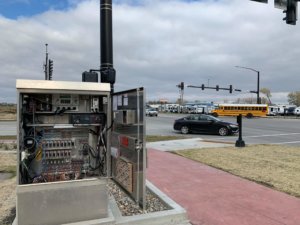Inefficient Traffic Signals Cause Unneeded Delays and Congestion
Almost every driver has experienced the annoyance of getting stopped by a red light at a deserted intersection. Or just the opposite, traffic so congested that you’ve had to wait through several green arrows to make a left turn. At times, it feels like the traffic signals are conspiring against us. Why can’t the traffic signals adjust to actual roadway conditions?
With typical traffic signals, retiming might only occur every few years, and the process relies on time-consuming, manually collected data over several days. Even then, standard time-of-day signal timing plans don’t accommodate for variable and unpredictable traffic patterns. To make matters worse, when poorly timed, traffic signals (particularly along busy corridors) significantly contribute to traffic congestion, excess fuel consumption, and frustrated drivers.
Automated Traffic Signal Performance Measures (ATSPM) and Adaptive Signal Control Technology (ASCT)
Two potential solutions are the addition of Automated Traffic Signal Performance Measures (ATSPM) or Adaptive Signal Control Technology (ASCT) to help smooth out and control traffic flow. These solutions use multiple detection methods to gather real-time traffic information and monitor the signal system’s performance along an entire corridor. An ATSPM system relays that information to a traffic engineer or technician to monitor the signal performance and make necessary timing changes at an intersection based on that information.
An ASCT system takes things one step further. Instead of sending the data to a traffic engineer for assessment, the system evaluates the information, and an algorithm develops signal timing adjustments. The ASCT continually implements the updates, sharing information between signals to adjust timing. These constant adjustments accommodate traffic patterns different from the peak periods (during which the timing plans were designed to operate) and help keep traffic flowing smoothly.
The traffic engineering experts with Snyder & Associates are well-versed in helping communities evaluate the factors leading to the requirement and implementation of an ATSPM or an ASCT system. Most recently, our team worked with the City of Waukee to implement an ATSPM system throughout the community with the option to add ASCT. Likewise, we’re also helping the City of Burlington implement performance measures along the US Highway 61 corridor through town. These improvements could also lead to an ASCT system if needed.
Our experience with ASCT implementation is just as vast. Our team recently worked with the City of Pleasant Hill to address ASCT needs along the busy Iowa Highway 163 corridor and the Cities of Clive and Urbandale to spearhead installing an ASCT system along US Highway 6.
Systems Engineering Determines Need for ATSPM & ASCT
A systems engineering study is generally done to determine if an ATSPM or ASCT system is necessary for a corridor. A systems engineering study is a meticulous process that follows guidelines established by the Federal Highway Administration (FHWA) and is also a requirement of most state DOTs to be eligible for grants and other federal program funding.
Because numerous traffic signal management and adaptive control systems are available, it’s critical to know the existing conditions of a corridor before issuing a Request for Proposals (RFP). To that end, a systems engineering study looks at peak/off-peak traffic conditions, and studies turning movement counts along a corridor. A thorough study will also inventory the current signal controller equipment in use, the communications network in the area, and any geometric concerns that may need to be addressed at individual intersections. Other improvements to modify signal controller cabinet equipment or update the communication network in the area are considered. Fiber optic connectivity is a strong necessity for all ATSPM and ASCT installations to provide the level of communication necessary for optimal performance.
Physical Impacts of ATSPM Implementation
Implementing an ATSPM system along a corridor makes a noticeable impact on traffic flow. Namely, a performance measures system allows agency staff to review historical traffic signal operations to confirm citizen complaints and monitor traffic signal operations to identify faulty equipment. Signal timing adjustments can be made based on recent, continuous traffic conditions instead of the limited day traffic count.
Physical Impacts of Adaptive Signal Control Technology Implementation
The apparent impact of implementing an ASCT system is fewer delays due to congested traffic, reduced fuel consumption, and fewer frustrated drivers. The improvements, however, extend to numerous other benefits, including:
- Managing the queueing issues at intersections
- Detecting the changes in traffic conditions before and after special events
- Accommodating peak traffic periods and real-time changes in traffic volumes
- Quickly returning signal operations to regular coordination after disruption by pedestrian actuation and emergency vehicle preemption
- Reducing delays for side street traffic along a corridor
Cost Savings of ATSPM or Adaptive Signal Technology Implementation
The continued use of older traffic signal technology also incurs substantial costs to businesses and taxpayers. Inefficient signals account for more than ten percent of all traffic delays and congestion issues on major routes alone (source: highways.dot.gov). This results in excessive delays and fuel consumption for users, but for businesses, it decreases productivity and increases labor costs, ultimately passed on to the taxpayers.
Older signals also affect the costs of managing agencies. Personnel must be diverted from other tasks to respond to citizen complaints when traffic signals do not meet motorist needs. Personnel manually compile the data for traffic specialists, who then analyze it and develop updated signal timing using the traditional signal timing process before generating their recommendations. Because these specialists must balance the needs of one intersection against the requirements of an entire system, this is time-consuming and expensive.
On top of these practical benefits, automated traffic signal performance measures and adaptive signal control technologies are also kinder to the environment, as previously noted. An ATSPM system allows traffic engineers to update signal timings based on current traffic counts. In contrast, the ASCT system automatically adjusts signal timings to reduce emissions of hydrocarbons and carbon monoxide from vehicles by eliminating constant stop-and-go traffic situations.
You may wonder why anyone would install ATSPM when ASCT automates the process. ASCT systems typically cost around twice as much as the ATSPM systems. The traffic engineering experts at Snyder & Associates understand these costs and traffic flow characteristics and can assist in selecting the proper size solution.
Real-time management of traffic systems is proven to work, yet these systems require knowledgeable and experienced experts to determine the right solution for your situation. Snyder & Associates is working to help bring these technologies to our clients and markets. The deployment of an ATSPM or ASCT system is a critical step toward providing improved capabilities that allow affected communities to proactively manage traffic, enhance operations, increase mobility, and reduce congestion. For frustrated travelers, the optimal balance of red light/green light distribution is the ultimate payoff.

